| 1 | Ruler of Japanese rice fields |
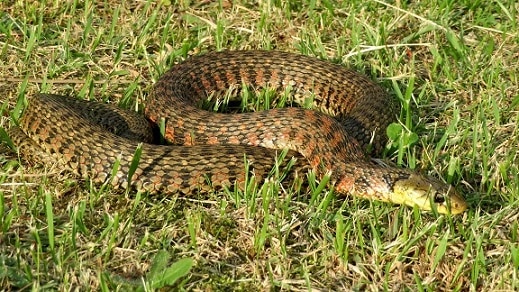
The tiger keelback is a common Japanese snake, which is found all over the main island of Honshu, and ranges from 50-115cm. It’s a flexible species in its habitats, appearing in forests, fields and river plains alike. Within each habitat, they tend to appear near water bodies, such as rivers, ponds or small streams. The reason we’re telling you this is that of all Japanese snakes, the tiger keelback is easily one of the deadliest.
Tiger keelbacks (Rhabdophis tigrinus) don’t quite match the mamushi for chaos inflicted annually, but occupy a respectable position in the country’s danger statistics. From 1971 to 2000, they caused 43 confirmed bites, and almost certainly many more unrecorded ones. 5 deaths were confirmed, with the nastiest symptom being cerebral haemorrhage.
Tiger keelbacks are a relatively calm venomous snake, never coiling up into an S-shape and hissing like a viper. A high percentage of bites are dry as well. Nevertheless, tiger keelbacks are a major threat to tourists and dog walkers alike, even if they harbour no real ill will towards humanity.
Tiger keelbacks get more abundant in Japan the further west you travel, and are especially common in rice paddy fields, which brings them into close contact with humanity. While they kill less people than the mamushi, their venom is equally as deadly drop for drop.
| 2 | Feeds on poisonous frogs |
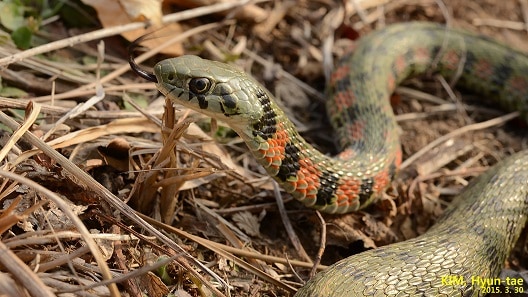
In nature, members of the Bufo toad family defend themselves against predators using bufadienolide toxins. These are secreted from their slimy skins, and a parotid gland behind their eye. These toxins have a mildly white colour, and targeted against the hearts of all creatures, from birds to humans. They slow the heart rate, while increasing the force of each pump, ultimately causing a heart attack. The mechanism is unknown, but they seem to damage the mitochrondria of individual heart cells, repeated many thousands of times.
Bufadienolides also produce a side helping of vomiting and convulsions. These toad toxins were even imported to the USA as a male aphrodisiac (apparently painful yet effective), before a spate of 4 deaths from 1993 to 1995 led to an FDA ban.
Why are we ranting about random toad toxins? Because like its cousin the red-necked keelback, Rhabdophis tigris can store bufadienolides in nuchal glands in their neck, after swallowing the toads containing them. They’re not only blessed with rare immunity to toxic bufadienolides, but can repurpose them for defence against predators.
| 3 | Blasts toxins from neck |
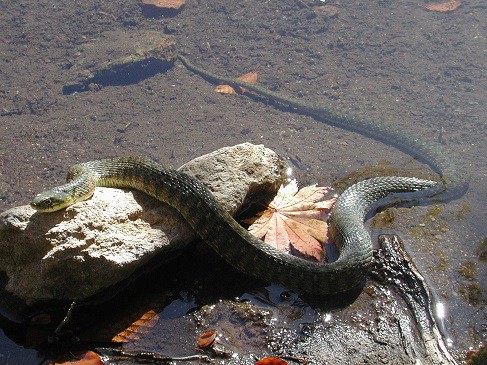
After storing these toad toxins, tiger keelbacks become poisonous themselves, deterring predators from eating them. This gives them the rare snake feature of being simultaneously venomous and poisonous. However, their most impressive skill is bursting these stored toxins in the faces of predators. This can cause severe eye pain, irritating mucous membranes and damaging corneal cells.
In Taiwan, tiger keelbacks acquire these toxins from the Bankor toad (Bufo bankorensis), while in Japan, the source is the Japanese common toad (Bufo japonicus). There are two nuchal glands, arranged in thin parallel rows on the spine of the snake’s neck. Most of a tiger keelback’s neck is dark grey, but these glands show up as pale white.
These nuchal glands have no ducts, but instead burst like delicate sacs. Individual cells rupture, ripping the thin membrane and causing the stored toad toxins to burst free in a release of pressure. The glands can be squeezed open by a snake’s muscles from within, or by a greedy predator’s talons like a bird (accidentally of course). In toads, the poisonous liquid is milky white, but once the tiger keelback stores it, it becomes yellow and opaque.
| 4 | Aims deliberately for the face |
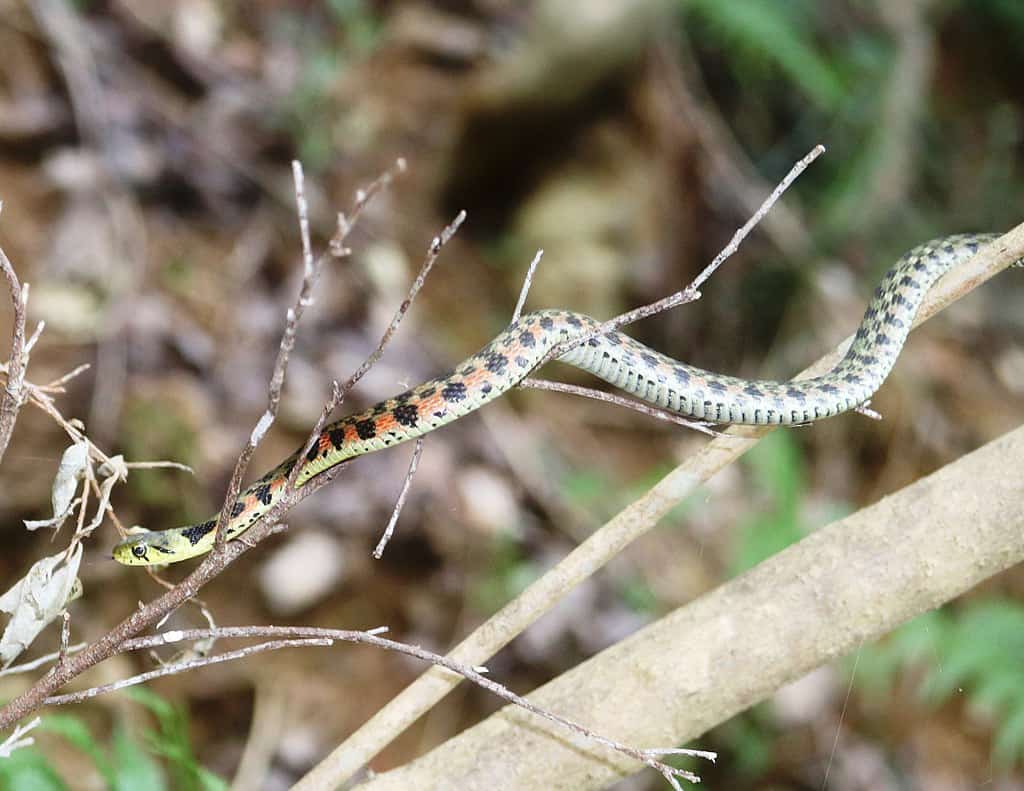
There are 3900 snakes worldwide, and only a handful possess these nuchal glands. Tiger keelbacks were the first snake in which they were discovered, back in 1935. This 1935 scientist was also one of the first official victims. He decapitated a tiger keelback with a pair of scissors, causing yellowish liquid to splash in his eyes, causing stinging pain. It then took 50 years before the toad toxin connection was discovered, with a 1986 study discovering 7 toxic compounds.
Another tiger keelback strategy is the neck arch, when they deliberately raise the poisonous section into the air. This is probably so that predators strike this area first, rather than going for the more vulnerable head.
Most disturbingly, the tiger keelback isn’t even the most extreme of this crew. The Hubei keelback, AKA Rhabdophis nuchalis, has nuchal glands extending down the entire length of its body. This is an insect eater, and instead of toads, it acquires the deadly bufadienolides from fireflies.
| 5 | Highly accurate, rarely misses |
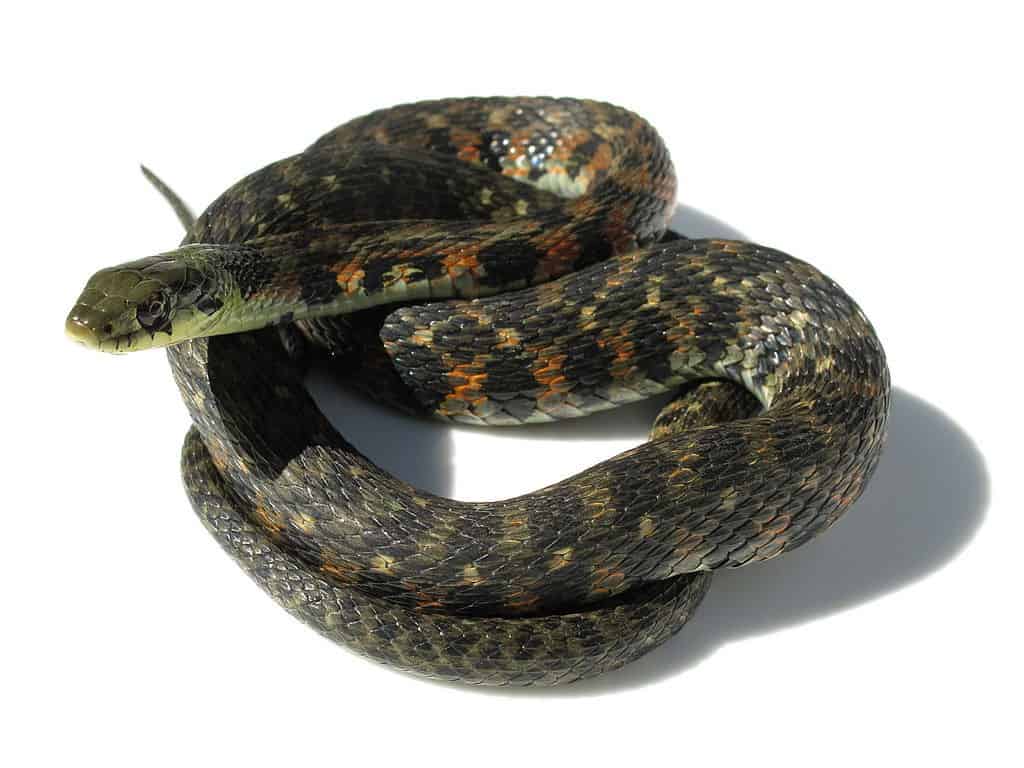
Tiger keelbacks are capable of firing their poison cloud from at least 1 metre away, striking with deadly accuracy. One story happened to a Taiwanese farmer in a remote mountain district. The 40 year old man noticed a snake outside his house, strode forward, and grabbed it with his bare hands.
Curiously, the man then noticed a dribble of liquid coming from the snake’s neck. Seconds later, there was a globule in his eye. A stinging pain kicked in and rapidly intensified, as the man wrestled the tiger keelback and forced it into a canvas bag. Before long, the man’s vision was seriously blurred, with a constant burning sensation.
Washing his eye under a tap failed to achieve anything. 10 hours post spray, the man arrived in hospital. No venom had entered his veins, and his vital signs were normal, but his corneal cells showed noticeable damage. The man was given medications, and 5 days later, he had recovered, which the doctors learnt via telephone, as his mountainous location was too remote to visit.
| 6 | Diet: mainly amphibians |
The tiger keelback is a frog and toad specialist. The occasional mammal has been found in their stomach, including wood lemmings, and fish such as sticklebacks, but amphibians make up the overwhelming majority. A study from a rice paddy field near Tsukuba City found that Japanese tree frogs were easily their favourite prey.
Tiger keelbacks prefer relatively cooler temperatures compared to some snakes. On Japan’s Yakushima Island, they were compared to four-lined snakes and found to prefer temperatures averaging at 22.0C, versus 25.2C. The snakes had reached an unspoken agreement on this island, as the four-lined snakes had exclusively lizards in their bellies, while the tiger keelbacks had exclusively frogs.
The two were naturally dividing up food supplies to ensure each other’s survival, an alliance of convenience, with each species occupying a comfortable ecological niche. Tiger keelbacks can also be found in rain gutters, swimming around and greedily swallowing up the tiny froglets. For some reason, they skip the tadpoles.
| 7 | Aware of its own powers |
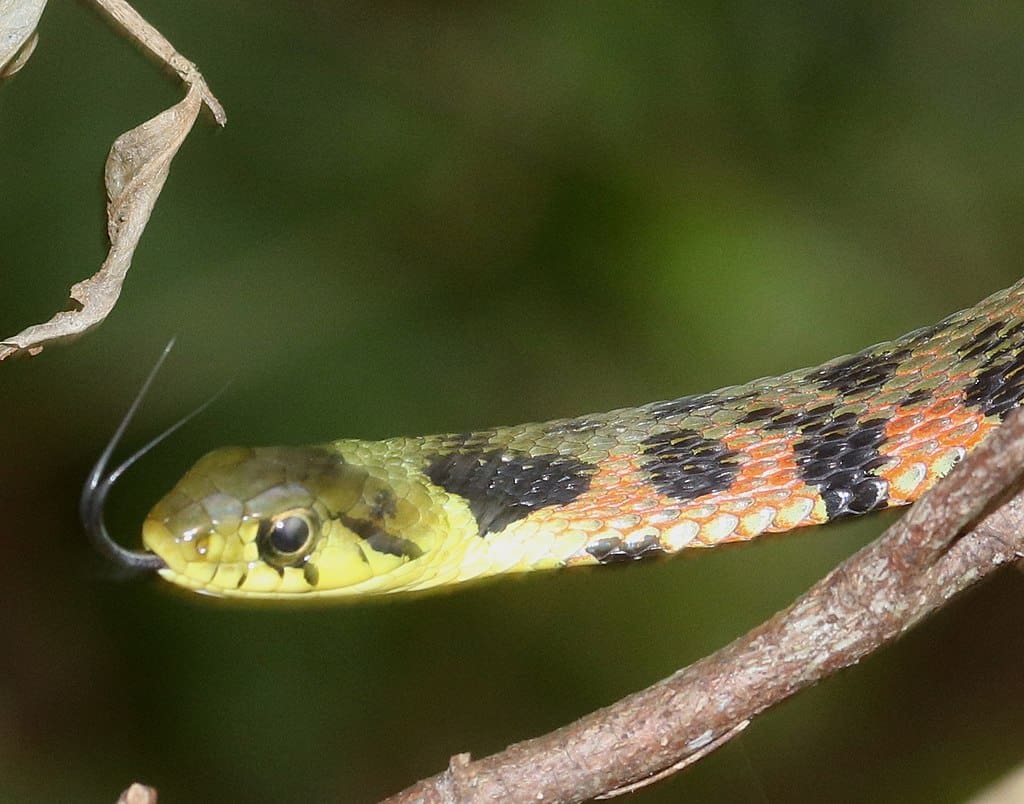
The red-necked keelback is another species which can store toad toxins and burst them in people’s faces. But the tiger keelback has the disturbing advantage of being aware of how poisonous it is. This species behaves differently when its nuchal glands are empty or full to the brim.
Scientists identified two Japanese islands: one with plenty of toads and one with none. The tiger keelbacks on the latter island were far more cowardly, fleeing into the bushes. The snakes on the toad-heavy island behaved normally, standing their ground and showing off their deadly nuchal glands prominently. Somehow, Rhabdophis tigris is aware of when it carries deadly poisons in its neck. Most animals are purely instinctive, so it’s possible that when the nuchal glands are full of bufadienolides, this triggers an automatic increase in hormones responsible for aggression.
Tiger keelback bites cause very little pain or swelling, like the mamushi, another snake which terrorises Japan. The dangers are concentrated on the inside.
| 8 | Don’t underestimate their fangs |
Tiger keelbacks also have a nasty main venom. They’re only a rear-fanged snake, producing venom through a Duvernoy’s gland rather than a traditional venom gland. They’re reluctant to strike, as they have to angle their jaws awkwardly to pierce the victim, and chew repeatedly when they do.
Nevertheless, the tiger keelback’s venom is powerfully haemorrhagic, specialising in a condition called disseminated intravascular coagulation (DC). This is rare in humans, and is when numerous small clots form spontaneously in small blood vessels. This depletes clotting agents like fibrinogen so far that the rest of the bloodstream cannot clot at all, causing spontaneous bleeding. Bleeding gums, blood-streaked urine, and uncontrollable bleeding from the bite wound are classic symptoms.
Tiger keelbacks particularly specialise in kidney failure, with some victims requiring dialysis. Fortunately, this snake has a dedicated antivenom. This was originally manufactured in 1985, by injecting rabbits and collecting the immune system antibodies, but these days horses are used, as with Brazilian pitvipers. In a 2014 study, this antivenom cut the rate of kidney failure requiring dialysis from 40% to 5.3%.
| 9 | Suddenly migrates during summer |
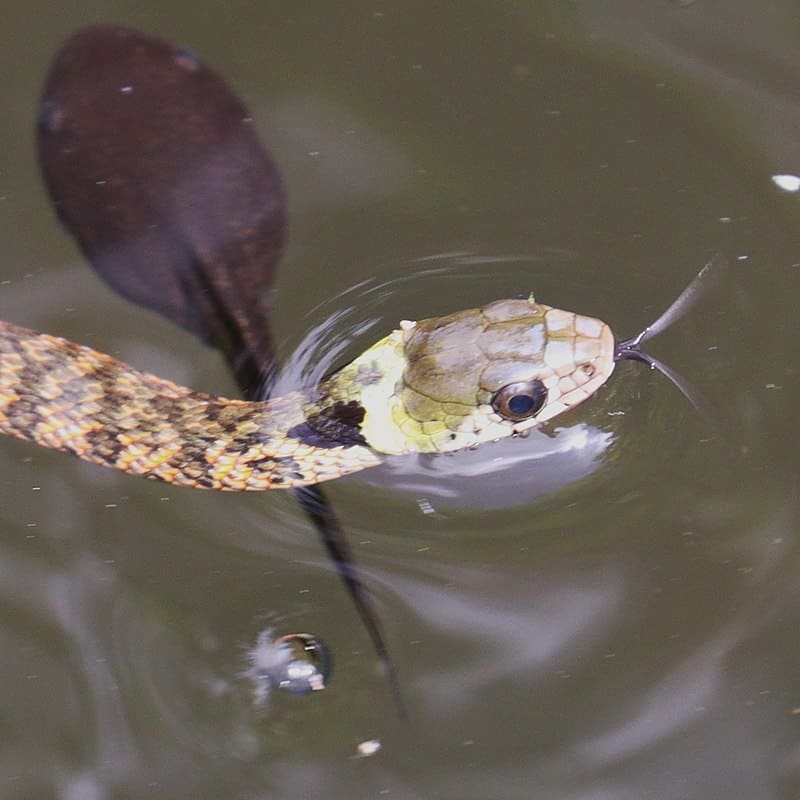
Tiger keelbacks aren’t aquatic snakes, but are commonly found near water bodies. They have a seasonal migration pattern, an urge found in all tiger keelbacks which randomly revs up on occasional and forces them to get moving. In spring, they prefer the grassy shores of large rivers. A 2014 study found that all 34 males tracked were within 50 metres of a river. In summer, they move to drier land, such as small brooks, or the centres of dense forests well away from water bodies.
Tiger keelbacks get particularly itchy around late July, and can suddenly migrate large distances. Snake in the study above moved 285 or even 580 metres to seek out more adventurous summer haunts. Eventually, leaves start dropping and temperatures start falling, and tiger keelbacks move to their winter hibernation sites. These are usually rocky slopes directly adjacent to their original river domain, with a south-facing angle for higher sunlight absorption.
Unlike the white-lipped pitviper, tiger keelbacks aren’t particularly territorial. They’ll happily overlap with their fellow species members, sharing a hollow near a stream or a patch of moist woodland.
| 10 | Mothers pass on their toxins |
Tiger keelbacks also give their children a nice inheritance (nasty for others). Rather than family jewellery or a house in the countryside, keelback mothers pass on some of their own stored bufotoxins. Newborns can be born with their own stash, before they’ve ever eaten a single toad. In fact, expecting mothers gain a sudden taste for toads, and will pursue them through the Japanese undergrowth.
This inheritance study also shone an accidental light on their diet. In the mountainous forests of northern Kyoto Prefecture, it found that two frog species contributed 89% of calories: the Japanese gliding frog and Kinugasa flying frog. The toxic Japanese toad contributed just 0.9% ordinarily. But when mothers were stuffed with eggs, ready to burst, the instinct for toads became irresistible. In a separate experiment, tiger keelback hatchlings from captive mothers were born without any bufadienolides.
Mother tiger keelbacks are smart in other ways as well. Up to 60 eggs have been found below one wooden railway sleeper, which were believed to come from 3 separate batches. Mother keelbacks can sniff out their fellow kind’s eggs and lay them together for assured safety.
Another interesting phenomenon is that the tiger keelback’s personality is controlled by the weather. In cooler conditions, they’re more likely to stay still, elongating their body to create a false impression of size, or arching their poisonous necks up. In warm conditions, meanwhile, they’re more likely to flee for the undergrowth.
